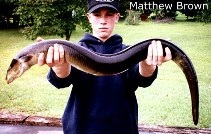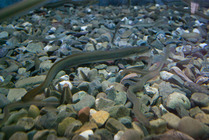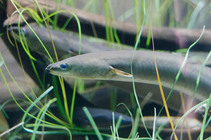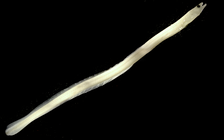Deep-Sea taxon details
Anguilla rostrata (Lesueur, 1817)
158562 (urn:lsid:marinespecies.org:taxname:158562)
accepted
Species
Leptocephalus grassii Eigenmann & Kennedy, 1902 · unaccepted
marine, brackish, fresh, terrestrial
(of ) Lesueur, C. A. (1817). A short description of five (supposed) new species of the genus Muraena, discovered by Mr. Le Sueur, in the year 1816. <em>Journal of the Academy of Natural Sciences, Philadelphia.</em> v. 1 (pt 1, no. 5) (19 Aug.): 81-83.
page(s): 81 [details]
page(s): 81 [details]
Distribution Greenland south along the Atlantic coast of Canada and US to Panama
Distribution Greenland south along the Atlantic coast of Canada and US to Panama [details]
Froese, R. and D. Pauly. Editors. (2024). FishBase. Anguilla rostrata (Lesueur, 1817). Accessed through: Glover, A.G.; Higgs, N.; Horton, T. (2024) World Register of Deep-Sea species (WoRDSS) at: https://www.marinespecies.org/DeepSea/aphia.php?p=taxdetails&id=158562 on 2024-04-26
Glover, A.G.; Higgs, N.; Horton, T. (2024). World Register of Deep-Sea species (WoRDSS). Anguilla rostrata (Lesueur, 1817). Accessed at: https://www.marinespecies.org/deepsea/aphia.php?p=taxdetails&id=158562 on 2024-04-26
original description
(of ) Lesueur, C. A. (1817). A short description of five (supposed) new species of the genus Muraena, discovered by Mr. Le Sueur, in the year 1816. <em>Journal of the Academy of Natural Sciences, Philadelphia.</em> v. 1 (pt 1, no. 5) (19 Aug.): 81-83.
page(s): 81 [details]
context source (Deepsea) Intergovernmental Oceanographic Commission (IOC) of UNESCO. The Ocean Biogeographic Information System (OBIS), available online at http://www.iobis.org/ [details]
context source (Bermuda) Smith-Vaniz, W. F.; Collette, B. B.; Luckhurst, B. E (1999). Fishes of Bermuda: History, zoogeography, annotated checklist, and identification keys (American Society of Ichthyologists and Herpetologists - Special Publication No.4) . ASIH, 424 pp. [details]
basis of record Scott, W.B., and S.N. Messieh. (1976). Common Canadian Atlantic fishes. <em>Huntsman Marine Laboratory. St. Andrews, N.B.</em> 106 p. [details]
additional source McEachran, J. D. (2009). Fishes (Vertebrata: Pisces) of the Gulf of Mexico, Pp. 1223–1316 in: Felder, D.L. and D.K. Camp (eds.), Gulf of Mexico–Origins, Waters, and Biota. Biodiversity. Texas A&M Press, College Station, Texas. [details]
additional source Lutaenko, K.A.; Furota, T.; Nakayama; S.; Shin, K.; Xu, J. (2013). Atlas of Marine Invasive Species in the NOWPAP Region. Beijing: NOWPAP DINRAC (Northwest Pacific Action Plan, Data and Information Network Regional Center). 189 pp. [details]
additional source Froese, R. & D. Pauly (Editors). (2023). FishBase. World Wide Web electronic publication. version (02/2023)., available online at https://www.fishbase.org [details]
additional source Gulf of Maine Biogeographic Information System (GMBIS) Electronic Atlas. 2002. November, 2002. [details]
ecology source Looby, A.; Erbe, C.; Bravo, S.; Cox, K.; Davies, H. L.; Di Iorio, L.; Jézéquel, Y.; Juanes, F.; Martin, C. W.; Mooney, T. A.; Radford, C.; Reynolds, L. K.; Rice, A. N.; Riera, A.; Rountree, R.; Spriel, B.; Stanley, J.; Vela, S.; Parsons, M. J. G. (2023). Global inventory of species categorized by known underwater sonifery. <em>Scientific Data.</em> 10(1). (look up in IMIS), available online at https://doi.org/10.1038/s41597-023-02745-4 [details]
page(s): 81 [details]
context source (Deepsea) Intergovernmental Oceanographic Commission (IOC) of UNESCO. The Ocean Biogeographic Information System (OBIS), available online at http://www.iobis.org/ [details]
context source (Bermuda) Smith-Vaniz, W. F.; Collette, B. B.; Luckhurst, B. E (1999). Fishes of Bermuda: History, zoogeography, annotated checklist, and identification keys (American Society of Ichthyologists and Herpetologists - Special Publication No.4) . ASIH, 424 pp. [details]
basis of record Scott, W.B., and S.N. Messieh. (1976). Common Canadian Atlantic fishes. <em>Huntsman Marine Laboratory. St. Andrews, N.B.</em> 106 p. [details]
additional source McEachran, J. D. (2009). Fishes (Vertebrata: Pisces) of the Gulf of Mexico, Pp. 1223–1316 in: Felder, D.L. and D.K. Camp (eds.), Gulf of Mexico–Origins, Waters, and Biota. Biodiversity. Texas A&M Press, College Station, Texas. [details]
additional source Lutaenko, K.A.; Furota, T.; Nakayama; S.; Shin, K.; Xu, J. (2013). Atlas of Marine Invasive Species in the NOWPAP Region. Beijing: NOWPAP DINRAC (Northwest Pacific Action Plan, Data and Information Network Regional Center). 189 pp. [details]
additional source Froese, R. & D. Pauly (Editors). (2023). FishBase. World Wide Web electronic publication. version (02/2023)., available online at https://www.fishbase.org [details]
additional source Gulf of Maine Biogeographic Information System (GMBIS) Electronic Atlas. 2002. November, 2002. [details]
ecology source Looby, A.; Erbe, C.; Bravo, S.; Cox, K.; Davies, H. L.; Di Iorio, L.; Jézéquel, Y.; Juanes, F.; Martin, C. W.; Mooney, T. A.; Radford, C.; Reynolds, L. K.; Rice, A. N.; Riera, A.; Rountree, R.; Spriel, B.; Stanley, J.; Vela, S.; Parsons, M. J. G. (2023). Global inventory of species categorized by known underwater sonifery. <em>Scientific Data.</em> 10(1). (look up in IMIS), available online at https://doi.org/10.1038/s41597-023-02745-4 [details]
 Present
Present  Inaccurate
Inaccurate  Introduced: alien
Introduced: alien  Containing type locality
Containing type locality
From regional or thematic species database
Introduced species impact Chinese part of the Yellow Sea (Marine Region) Outcompetes native species for resources and/or space [details]Introduced species impact Chinese part of the South China Sea (Marine Region) Genetic impacts: hybridisation and introgression [details]
Introduced species impact Chinese part of the Eastern China Sea (Marine Region) Outcompetes native species for resources and/or space [details]
Introduced species impact Chinese part of the South China Sea (Marine Region) Outcompetes native species for resources and/or space [details]
Introduced species impact Chinese part of the Yellow Sea (Marine Region) Genetic impacts: hybridisation and introgression [details]
Introduced species impact Chinese part of the Eastern China Sea (Marine Region) Genetic impacts: hybridisation and introgression
[details]
Introduced species vector dispersal Chinese part of the South China Sea (Marine Region) Aquaculture [details]
Introduced species vector dispersal Chinese part of the Eastern China Sea (Marine Region) Aquaculture
[details]
Introduced species vector dispersal Chinese part of the Yellow Sea (Marine Region) Aquaculture [details]
From other sources
Diet At sea, young eels feed on plankton, juveniles and adults feed on bottom fishes and invertebrates. In freshwater, diet includes insect larvae, worms, crayfishes, snails, frogs and small fishes [details]Distribution Greenland south along the Atlantic coast of Canada and US to Panama [details]
Habitat nektonic [details]
Habitat Anadromous; born in Sargasso Sea, drift for one year to North American waters, live in flowing streams for several years, spawn in Sargasso Sea. [details]
Importance Scientific- Commercial; aquaculture; gamefish [details]
Predators Sharks, rays and larval eels and elvers are eaten by their own kind [details]
Reproduction Spawn (once per lifetime) between February and July; external fertilization [details]
| Language | Name | |
|---|---|---|
| Danish | Amerikansk ferskvandsål | [details] |
| Dutch | Amerikaanse paling | [details] |
| English | freshwater eelAmerican eel | [details] |
| French | anguille d'Amériqueanguille d’Amérique | [details] |
| German | Amerikanischer Aal | [details] |
| Japanese | アメリカウナギ | [details] |
| Spanish | anguila americana | [details] |
To Barcode of Life (111 barcodes)
To Biodiversity Heritage Library (284 publications)
To Biodiversity Heritage Library (6 publications) (from synonym Leptocephalus grassii Eigenmann & Kennedy, 1902)
To Biological Information System for Marine Life (BISMaL)
To European Nucleotide Archive (ENA)
To FishBase (from synonym Leptocephalus grassii Eigenmann & Kennedy, 1902)
To FishBase
To FishBase images (Anguilla rostrata, by The Native Fish Conservancy)
To GenBank (80774 nucleotides; 954 proteins)
To Global Biotic Interactions (GloBI)
To IUCN Red List (Endangered)
To NMNH Extant Collection (Anguilla rostrata P00690 illustration)
To NMNH Extant Collection (Anguilla rostrata RAD105826-001)
To ITIS
To Biodiversity Heritage Library (284 publications)
To Biodiversity Heritage Library (6 publications) (from synonym Leptocephalus grassii Eigenmann & Kennedy, 1902)
To Biological Information System for Marine Life (BISMaL)
To European Nucleotide Archive (ENA)
To FishBase (from synonym Leptocephalus grassii Eigenmann & Kennedy, 1902)
To FishBase
To FishBase images (Anguilla rostrata, by The Native Fish Conservancy)
To GenBank (80774 nucleotides; 954 proteins)
To Global Biotic Interactions (GloBI)
To IUCN Red List (Endangered)
To NMNH Extant Collection (Anguilla rostrata P00690 illustration)
To NMNH Extant Collection (Anguilla rostrata RAD105826-001)
To ITIS













